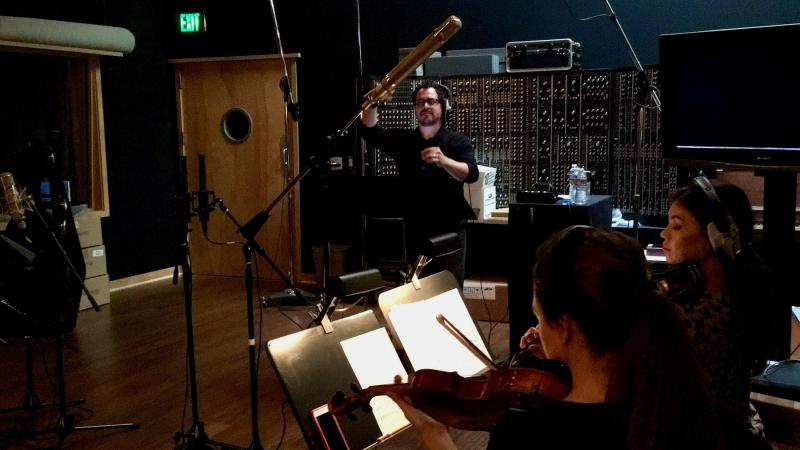Hal M. DeLong ’24 graduated from Lawrence University in June with a double major in geosciences and German. He did his Chandler Senior Experience research on the human, geological, and cosmic story of an iron meteorite from Namibia that is in the Geosciences Department’s collection. Marcia Bjornerud, the Walter Schober Professor of Environmental Studies and professor of geosciences, found the meteorite fragment in a locked box in a sub-basement beneath old Stephenson Hall a week before the building was torn down in 1998 to make way for Steitz Hall of Science. There is a partially legible label on the meteorite that reads, "German Southwest Africa," which was the colonial name of Namibia until 1919. In his report below, DeLong explores how the fragment came to be at Lawrence and the stories it can tell.
---
Some 70,000 years ago, a great streak of light tore across the sky, the end of its path marked with a flash: a massive explosion miles above the desert landscape of southwest Africa. This violent spectacle threw chunks of metal, with an aggregate weight 26 tons, still smoldering, even partly molten, across a vast swath of the desert.
Though it’s unknown if this incredible event was witnessed by early human eyes, the pieces it left certainly did make themselves known to a number of groups: the Nama people, colonial-era explorers, and modern geoscientists, to name a few. This was the beginning of the earthly story for what today is known as the Gibeon Meteorite, which exploded in the skies over what today is Namibia all those thousands of years ago.
And somehow, a small piece of this meteorite ended up at Lawrence University, only to be forgotten about and nearly lost forever. Just how did it end up here—and what stories lie hidden in this little piece of cosmic metal?
Before delving into these mysteries, it’s worth explaining how I came to realize there was something special about Lawrence’s Gibeon fragment. Our paths first crossed during Winter Term of 2023, during a session of History of Earth and Life with Professor Marcia Bjornerud. On this particular day, we discussed how different stages in the development of the solar system are recorded in different types of meteorites, all the while passing around hand samples of the different types to literally get a feel for them. Every rock we see, ever rock we touch, tells a story—and as budding geoscientists, my peers and I are taught well to “read” rocks to interpret those stories that are hidden within.
The meteorite samples we passed around, with ages of around four and a half billion years, tell stories that are key in understanding how Earth came to be: most stony meteorites are samples of the primordial matter from which the solar system formed, older than the planets themselves; iron meteorites are a bit younger, born in the hearts of massive bodies large and long-lived enough for the metallic elements within to sink to their cores (much like Earth with its metallic core)—though unlike Earth, these bodies too were ripped apart, sending pieces of their metallic hearts adrift through the vacuum of space. Many of these bodies are still out in space, dancing in the voids between planets as asteroids.
The small fragment of the meteorite landed in storage at Lawrence University.
Others, though, end up on crash courses with the larger bodies that outlived them, and some of these tear through Earth’s atmosphere as meteors. Hurtling in from space, most meteors experience violent ends when they strike Earth’s surface or, in the case of the Gibeon, explode while still airborne. Once they hit the ground, these messengers from the early solar system are deemed meteorites: keepers of geologic stories older than any found on Earth.
When the meteorite fragment reached me, I felt not only awe of these hidden stories, but also surprise. One side of the sample had a spectacular cross-hatched pattern on it, reflecting the crystallization of molten iron-nickel alloy deep in the interior of an ancient ill-fated planet. This was the side to look at for those stories of deep time we were to explore in that course. But I flipped it over before sending it on to the next person, and was greeted with another surprise in the form of a damaged label sticker:
“MUKEROP/ (Amalia-Goamus)/ Ger. S. W. Africa, Off./ Finest Oct., F’d 19[XX], [X]OO[X…]”
I wasn’t expecting this little record-keeper to bear signs of a literally legible story. But this is where my other major comes into play. Being a student of German as well as geoscience, I have learned much about the German Empire’s colonial exploits in Africa, from the “Scramble for Africa” in the 1880s through Germany’s forced ceding of its colonies at the conclusion of World War I. I recognized instantly that this piece, in having its place of discovery named, doubtlessly had some sort of ties to German colonialism in Namibia (once known as German Southwest Africa). But how did this chunk of cosmic metal make its way from a former German colony to a university some 8,000 miles away?
A damaged label provides clues to the meteorite fragment.
I pondered this as Professor Bjornerud told us a story about how she rediscovered the meteorite samples we handled. In 1998, prior to the construction of Steitz Hall, the building then at that site, Stephenson Hall—the long-time home of the Geology Department—had to be emptied and demolished. Moving everything in the department, including a century’s worth of rocks, books, and equipment, was a formidable task. Just a week prior to the wrecking machines’ arrival, however, a forgotten subbasement under Stephenson was found hidden behind a display case, filled to the ceiling with crates of more rock samples.
Professor Bjornerud, then still fairly new to Lawrence, knew that it would be impossible to save everything, and decided to focus on identifying and rescuing unique or noteworthy samples. In searching through the basement, a further odd discovery was made: a locked metal box. With a few hits from a rock hammer, the box was opened, and inside was a collection of meteorites. Had that box not been cracked in time, had that basement not been rediscovered in time, these time-traveling artifacts would have been lost forever. To think that all that separated billions of years of storytelling from being lost to us was a matter of days…
This fascinating story again begged the same question: how did this meteorite end up here? And beyond that, how and why was it forgotten about? How many other stories might be hidden within the patterns dancing on the surface of this little piece of metal?
These were the questions I sought to uncover in my senior capstone project, using research resources here at Lawrence. Though my majors may seem to be largely discrete fields of study, this is not so. Earlier in my junior year, I wasn’t quite sure if I could find an interdisciplinary capstone project involving German and geoscience. In first meeting this meteorite, I knew I’d found at least one solid connection.
Get to know Earth's past, present, and future with the multidisciplinary study of geosciences.
These connections only grew in number with the more scholarly research I’d uncovered online. Using resources including the Mudd Library’s online scholarly search tools, I discovered that German-speaking scientists made fundamental contributions to the study of meteorites. In fact, it was a German scientist, Ernst Chladni, who in 1794, was the first in modern Western science to suggest that meteorites had an extraterrestrial origin. Another German scientist, E. Wiechert, was in 1897 the first to suggest that iron-nickel meteorites originated in the cores of ancient planetoids, a bold statement considering this predated the confirmation of Earth having a metallic core by some three decades.
Beyond connections such as these, my work on the meteorite’s “biography” was also united by the analytical approaches of my two disciplines. In the German department, an approach commonly used in classes is New Historicism, which entails interpreting works or artifacts of any medium as texts that in association with each other also speak to the cultural contexts they are developed within. In the Geosciences Department, similarly, we see rocks as complex texts. Professor Bjornerud calls this “reading the rocks”—learning the ways in which various events and processes leave their signatures in rock. I realized that my two majors, as dissimilar as they seem, ultimately employ quite similar methods of analysis. By bringing both together in a reading of this meteorite and texts surrounding the larger Gibeon Meteorite, I’ve been able to compile a much more holistic version of the story than would otherwise have been possible.
That brings us back to the Lawrence connections. What do known documents say about how a piece of the Gibeon meteorite ended up here?
Though a definitive answer was ultimately not uncovered during my project (though one may exist out there somewhere!), the deep dives I took into Lawrence's archives, with the help of archivist Claire Cannell, did suggest a likely chain of events. The incomplete label no longer lists a full year (19[XX]), but based on tiny flecks of ink that remain, it can be reasonably interpreted that the third number is a 1. Based on when the German colony of German Southwest Africa existed, that narrows it down slightly further to 1910 to about 1918. The names “Mukerop (Amalia-Goamus)” on the label indicates it was found on one of the neighboring colonial-era farmsteads of Amalia and Goamus, near where a sacred rock formation known as the Mukurob, or Mukerop, stood. Though not part of the meteorite itself and unrelated beyond the name, the Mukurob also had its place as an important piece of geological history in Namibia. Several variations of myths surround the former sandstone finger jutting into the sky, fittingly named “God’s Finger” in the language of the local Nama people. One such story states that once the formation fell, the reign of white colonial control in the country would come to an end. And it did—only about a year after the Mukurob fell following heavy rains in 1988, Namibia achieved independence from South Africa.
The Gibeon meteorite, found in the same region, has also been an important part of Nama culture. For centuries Nama artisans have used meteoritic iron to craft spearheads and other objects and the meteorite fragments are considered national treasures with strict legal protections. Today, even searching for remaining meteorite pieces is illegal. These regulations represent a reaction to exploitation during colonial times, when settlers (largely white Europeans, especially Germans pre-WWI) collected literal tons of Gibeon material to be shipped back to Europe. This fostered a substantial amount of geologic research to be done, but at a great cost: the plundering of resources, including minerals and meteorites, was part of a larger humanitarian crisis that culminated with the genocide of the native Nama and Herero under German rule from 1904 to 1908.
… But back to Lawrence.
I spent many hours in the Mudd Library’s archives, with guidance from Cannell, poring over the entire documented history they have on the Geology (and since 2019, Geoscience) Department at Lawrence. Going through about 100 years’ worth of documents is no small task. Where does one even start? Armed with a trusty notebook and pencil, I went through folder by folder, box by box, taking notes on each document that might yield clues as to how this meteorite piece got to Lawrence. That brought me to this most likely chain of events:
"Going through about 100 years’ worth of documents is no small task. Where does one even start? Armed with a trusty notebook and pencil, I went through folder by folder, box by box, taking notes on each document that might yield clues as to how this meteorite piece got to Lawrence."
Hal M. Delong '24
In the 1940s, several students in the geology department were destined to go on to adventurous international careers in mineral exploration. Among these students was Harry Abendroth ’49, a protégé of Professor William (Bill) Read (1941-81), an avid researcher and collector of North American meteorites. The locked box from the Stephenson Hall subbasement included several other meteorites—all from North America—and notes written by Read. But the sole Namibian sample is a definite outlier. A possible clue to how it ended up in his collection appears in an article in The Lawrentian from Jan. 20, 1956. The article describes a visit from alumnus Abendroth in late 1955, in which he gave a presentation to students and faculty of the Geology Department: “Abendroth recently returned from several years of field work on chrome deposits in the Transvaal [South Africa]. … The geologist illustrated his remarks with colored slides showing methods of mapping and diamond drilling, as well as with pictures of rock types encountered and general views of the terrain. A suite of specimens, also used to illustrate the lecture, was left by Abendroth to be added to the Lawrence minerals collection.”
Although the article does not mention the specific nature of these specimens, it’s entirely likely that the Gibeon fragment was among them. Given the geographic proximity of South Africa to Namibia and Abendroth’s interest in metals, it’s possible that the Gibeon sample may have been picked up somewhere along his travels in southern Africa and given as a gift to his old mentor, Professor Read, during this visit.
Reading the rocks doesn’t always mean reading word-for-word. Sometimes, reasonable interpretations have to be made in the face of some uncertainty. While there is no means to verify the story beyond any doubt, we now have a general sense of the journey that this ancient metallic globetrotter (and space-trotter!) took from the depths of the solar system to southern Africa to a Lawrence subbasement and back into the classroom.
There is history that is yet to be written, too. In the interest of repatriating this piece, given that it was collected during colonial times under ethically dubious circumstances, I contacted the National Earth Science Museum in Windhoek, the capital of Namibia, to see if they would be interested in receiving this piece. They said yes! The next leg of its journey is now on the horizon, returning it to the land it rightfully belongs to after all this time.



